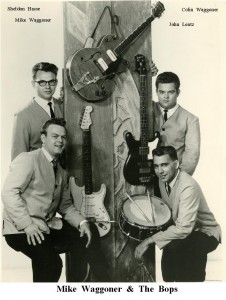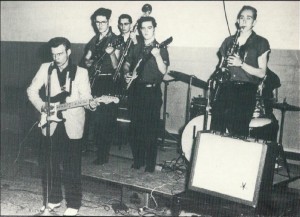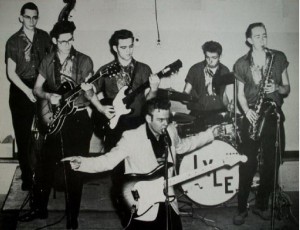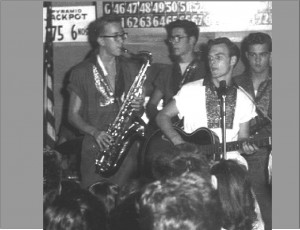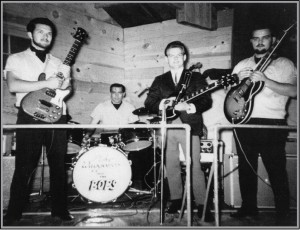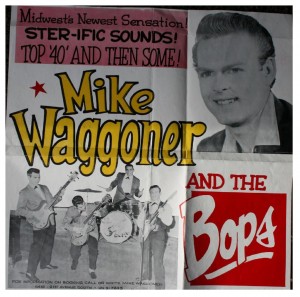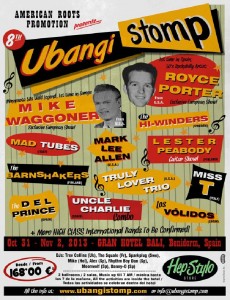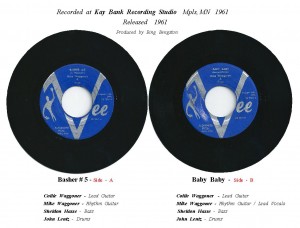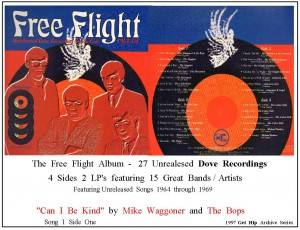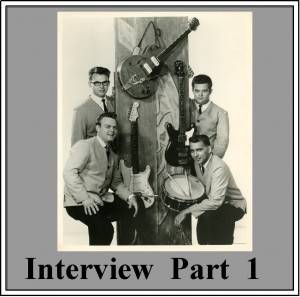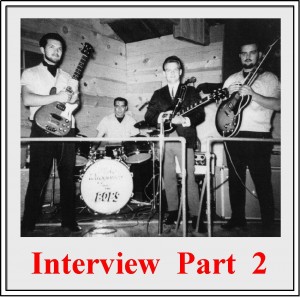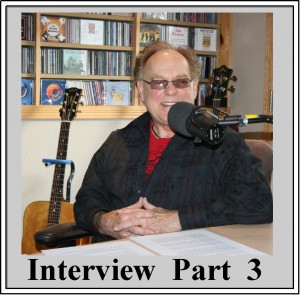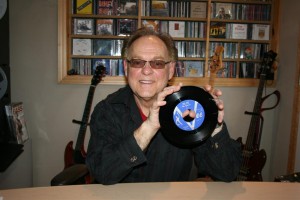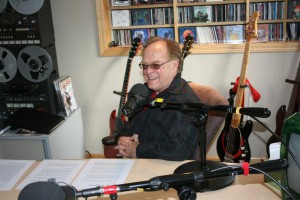Mike Waggoner and The Bops
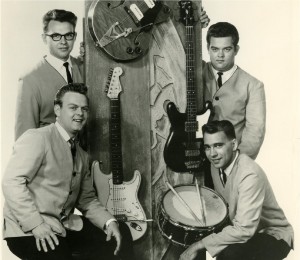 From Country roots to an opening slot for the Rolling Stones
From Country roots to an opening slot for the Rolling Stones
History
Mike Waggoner
and The Bops
1956 – 1964
1950: 10 year old Mike Waggoner begins singing and playing guitar with his father’s three-piece country band. Mike and his family live on a farm in Pine County, West of Hinckley, Minnesota. Most all of his family members and relatives play a musical instrument.
1953: At age 13, Mike makes his first debut on television, playing on the Toby Prin Talent Show (WCCO), the Jimmy Valentine Talent Show (KSTP), and the David Stone Talent Show (also on KSTP).
Fall, 1954: The Waggoner family moves from Pine County to Richfield, a south suburb of Minneapolis. Mike starts 9th grade in Richfield, a city filled up with baby boomers ready to embrace a “brand new” type of music for their generation called Rock’n’Roll.
1955: Mike finds WLOL on the radio dial (1330 AM) and tunes into DJ Carl Peterson, the “all night jock.” On Sunday nights, Mike discovers he can pick up a number of out state radio stations by moving the position of his radio, including: WLS (Chicago); KHJ (Pittsburgh); and KOMA (Oklahoma City). Listening to Bill Haley and the Comets, Elvis, Johnny Cash, Gene Vincent, Carl Perkins, and Fats Domino, has an influence on Mike, who becomes a fan of Rockabilly music.
1956: Now in the 9th grade in High School, Mike puts a band together for a Variety Show put on by one of the teachers at the school, Wesley Cole. Mike performs a couple of Elvis songs and goes over well with the audience (girls screamed). Mike decides the time is right to put together his own band with his brother Colin (“Collie”) and other students at the school. The lineup for the new band (with no name) is: Mike Waggoner on rhythm guitar and lead vocals; Colin Waggoner on lead guitar and vocals; Lyle Gudmanson on drums; Rusty Bates on standup bass ; Dick Benedict on rhythm guitar and Doug Barton on Saxophone. At the bands first performance, a record hop at St. Richard’s Catholic Church in Richfield, the host Carl Peterson from WLOL tells Mike he needs a name for the band so he can introduce them. Mike comes up with a band name: The Bops, based on the Gene Vincent song “Dance to the Bop.” The band plays cover songs from Elvis, Gene Vincent, Buddy Holly, Richie Valenz, Chuck Berry, Rick Nelson, Fats Domino and other popular groups from the era.
1956 – 1958: The band plays at various venues around town where Carl Peterson is hosting his sock hops, including: the Ford Union Hall in St. Paul; the Laidlaw VFW in Minneapolis; the Bloomington Roller Rink (94th and Lyndale Avenue South); The Green Door in Hopkins; the VFW in Richfield (65th and Lyndale Avenue South) and various school dances. Since none of the band members are old enough to drive, they rely on their parents to drive them and their band gear to the jobs.
Spring, 1958: Mike graduates from Richfield High School (the very first graduating class for the school). The band goes through a transition period as some members go off to college and regroup as a four-piece band with Mike Waggoner; Colin Waggoner; Sheldon Hasse on standup bass and John Lentz on drums. The band continues to play at community and school dances and also pick up a steady job at the Crystal Coliseum on Friday nights (teen night). The Crystal Coliseum (a roller rink with a portable elevated stage), is one of the first venues to feature rock’n’roll bands in the twin cities area. Among the early rock’n’roll pioneer bands that perform at the Crystal Colisiem are Augie Garcia, the Delricos, the Glenrays, Damon Lee and the Diablos, The Dorados, and Jim Thaxter and the Travelers.
1960: The band plays for the opening weekend of a new teen club in town, Mister Lucky’s. The band is now booked by T.B. Skarning and begins to play the ballroom circuit in the five state Midwest area. The band also plays jobs that are booked through Jimmy Thomas, based in Laverne. With the help of Dick Shaak at Shaak Electronics, the band puts together custom built speaker cabinets with Shure commercial PA amps, and also builds a custom light show that features multi-colored lights (controlled with dimmer switches by the drummer). In addition, the band uses an Echo-plex on the lead guitar and also on the lead vocals. The device adds a reverb type of sound to the audio signals. At a cost of $300 each, most local bands do not have one Echo-plex, much less two of them. These innovations help to elevate the bands popularity. Del Upsahl with Del’s Music in Richfield, sponsors the band and provides them with equipment. The band is eventually featured in national editions of Gibson product magazines.
The band plays for the grand opening of the Hub Shopping Center in Richfield, playing outside in the parking lot. At a record store in the shopping center, HI FI Records, Mike is able to find the records that he hears played on the local and out state radio stations that he wants the band to cover and plays them for the band to learn.
March 13, 1961: The band records a number of songs at Kay Bank Studio, most are cover songs. Two of the songs recorded are “Basher #5” (an instrumental written by Collie Waggoner) and “Baby, Baby” (a Dale Hawkins song). The recording engineer for the session is Tom Jung. The songs are produced by Bing Bengston, Bobby Vee’s manager. Bobby Vee had recorded “Suzie Baby” at Kay Bank, released on the SOMA label in 1959.
April, 1961: A 45 is released on the Vee label with “Basher #5” on the A-side and “Baby Baby” on the B-side. Approximately 1,500 to 2,000 copies of the 45 are pressed. The record is packaged inside a plastic sleeve. At WDGY, Bill Diehl plays the B-side, “Baby, Baby” and Sam Sherwood at KDWB also plays the B-side. With the song getting airplay around town the band uses “Baby, Baby” in their radio promotion ads.
1961 – 1964: The band travels extensively, working primarily in the larger twin cities venues and the ballroom circuit in Minnesota, Northern Iowa, the Eastern Dakotas and Western Wisconsin. Butch Maness (from the Anoka band The Tresspassers) joins the band on bass guitar in 1963. The band developes a reputation for showing up for jobs on time, putting on a good show (and they also have their own sound and light equipment), making Mike and the Bops a popular act on the ballroom circuit. The band wins the coveted Minnesota Ballroom Owner’s Award for four years in a row, 1961 through 1964.
June, 1964: Mike receives a phone call from Ray “Big Reggie” Coulihan, who asks Mike if the band would open up a show for a relatively unknown British band, The Rolling Stones, booked to play Danceland in two weeks. Ray is concerned that the Rolling Stones may not do well and he wants a band at the venue that will carry on with the show if things don’t go well for the new band from England. Mike agrees to play the job.
June 12, 1964: Mike Waggoner and the Bops open up the first show in Minnesota for The Rolling Stones, at Danceland in Excelsior, located across the street from the popular Excelsior Amusement Park, adjacent to Excelsior Bay (Lake Minnetonka). About 200 to 250 people show up for the concert, with the Rolling Stones generating very little interest from the crowd.
Fall, 1964: The band is offered to play a number of jobs in Australia, New Zealand other countries, where American Rock and Rockabilly are very popular and in high demand. Mike, now married with two young children, declines the overseas jobs and decides to wind down the band and pursue a career in broadcasting. Mike enrolls at the Brown Institute in Minneapolis to study broadcasting and journalism and also obtains a First Class Radio Engineers License.
December 21, 1964: The band goes into Dove Recording Studio on 6217 West Lake Street in St. Louis Park for the first of two recording sessions. Playing on the first session are: Mike Waggoner; Dave Clausen (filling in for Collie who was in the service); Dan Matche on bass guitar; and John Lentz on drums.
March 13, 1965: The band returns to Dove Recording Studio for a second recording session. Collie is back on lead guitar for this session. From the Dove sessions, two songs are released as a 45 on the Dove label: “Blue Days, Black Nights” backed with “Where and When.” Both songs are written by Mike, with the A-side having a Buddy Holly influence and the B-side having a Del Shannon influence. The A-side of the disc is played by Charlie Boone and Roger Erickson on radio station WCCO (the Boone and Erickson show).
Fall, 1965: The band is offered to play a number of jobs in Australia, New Zealand other countries, where American Rock and Rockabilly are very popular and in high demand. Mike, now married with two young children, declines the overseas jobs and decides to wind down the band and pursue a career in broadcasting. Mike enrolls at the Brown Institute in Minneapolis to study broadcasting and journalism and also obtains a First Class Radio Engineers License.
Mike Waggoner and the Bops play their final job at Woodley’s Country Dam, a popular live music dance hall near Amery, Wisconsin.
UPDATE:
1965 – 1976: Mike entered into a new career, radio broadcasting, spending 11 years as an on air personality and as a music and program director at three AM stations: WEAQ inEau Claire,Wisconsin; WEBC inDuluth, and WDGY inBloomington).
1974: Mike put together a band called The Music Machine, which played primarily for weddings, class reunions, proms and community events. The band stayed together through 1978.
1976: Mike moved from broadcasting into radio sales at WCCO-FM (now WLTE).
1981: Mike moved into radio station management at KJJO-FM creating the “20 Years of Rock n’ Roll” format.
Mike Waggoner and the Bops performed with several other local bands at a concert at the Medina Ballroom. This concert is now considered to be the very first reunion concert in the twin cities to feature local bands from the 1950’s and 1960’s.
1986: Mike moved into sales at KMSP-TV.
1989: Mike moved into sales management at KSTP-TV.
1981: Mike Waggoner and the Bops performed with several other local bands at a concert at the Medina Ballroom. This concert is now considered to be the very first reunion concert in the twin cities to feature local bands from the 1950’s and 1960’s.
1997: A song recorded by Mike Waggoner and the Bops called “Can I Be Kind” was included on an album called: Free Flight, Unreleased Dove Recording Studio Cuts, 1964 – 1969.
2005: Mike Waggoner put together a new band called OSR (Old School Rockers) that played locally.
2008: Mike Waggoner and the Bops were inducted into the Midwest Music Hall of Fame, the ceremony and concert held at the Medina Ballroom.
2010: Mike Waggoner put together a new band called Memphis Trax. The band plays songs that showcase the evolution of rock’n’roll, rockabilly, blues and boogie. The band played their first public performance in July at the Richfield 4th of July celebration, headlining a street dance.
Mike Waggoner reported during the interview that various songs recorded by the Mike Waggoner and the Bops band have been released over the years on over 30 unauthorized compilation records and CD’s that feature early US rock and rockabilly songs. The most recent use of the bands songs is on a CD from France. The songs on the records and CD’s include both songs released on the band’s two 45 records and unreleased songs from the bands recording sessions at Kay Bank in Minneapolis and Dove Studio in St. Louis Park.
2013: Mike Waggoner continues to play live around town with two bands, Memphis Trax and Roadhouse.
May, 2013: Due to a connection made through minniepaulmusic.com, Mike Waggoner will be playing his first concert in Europe at the end of this year. The concert called “Ubangi Stomp” is an annual show that features bands from around the world that play early American Rock’n’Roll and Rockabilly music.
June 12, 1964: The Rolling Stones concert at Danceland in Excelsior.
The date June 12, 1964 has taken on legendary significance in the history of Minnesota music, as the date the relatively unknown British band, The Rolling Stones, played their first job in Minnesota, with Mike Waggoner and the Bops opening the show at Danceland in Excelsior. The Rolling Stones would have a huge hit the following summer with “Satisfaction” and would go on to become what many would say to be, the greatest rock’n’roll band in the history of popular music. The events of that day, the concert and the events following the concert would be the topic of conversation for decades to follow, with various and often conflicting information reported.
In 1969, with the release of The Rolling Stone’s album, “Let it Bleed” (now considered one of the greatest rock’n’roll albums ever recorded) a bizarre story unfolded surrounding a resident of Excelsior, Jimmy Hutmaker. The album contained a song called “You Can’t Always Get What You Want” which referred to a “Mister Jimmy” in the song lyrics. Jimmy Hutmaker, who was at the concert, claimed to have had a brief conversation in a local drug store (Bacon Drug) with Mick Jagger, the day after the concert. Jimmy claimed that the meeting with Mick Jagger was referred to in the song and that he was in fact, the “Mister Jimmy” in the song. The story generated numerous newspaper articles and television stories over the years, however, no one was ever able to verify the story. True or not, the story elevated Jimmy Hutmaker to a local celebrity and he became known as “Mister Jimmy.” It is known that The Stones returned to their hotel in Bloomington right after the concert at Danceland (with a stop at a drive-in restaurant to get some food). Timothy D. Kerr, local record executive/producer drove the band from Danceland to their hotel in Bloomington in his 1957 Chevy. Timothy D. Kerr has reported that his car was hit by eggs as it left Danceland and he stopped at a car wash on his way back to the hotel. The band left town the next day, the same day that Jimmy claimed to have met Mick Jagger at the drug store.
Jimmy Hutmaker suffered from a developmental disability of some sort that was never diagnosed and he roamed the streets of downtown Excelsior for years, talking to the local residents (and to himself), chewing on a cigar. A local resident provided Jimmy with business cards that stated Mister Jimmy on one side, with the lyrics to the Stones song on the back of the card. At one point, a local entrepreneur opened a restaurant in downtown Excelsior called Mick and Jimmy’s (in the building formerly occupied by Bacon Drug). The restaurant was not successful and closed shortly after opening. Hutmaker became ill in later years and passed away on October 3, 2007, at age 75. At the time of his passing, Jimmy was a resident in a nursing home in Excelsior.
On October 30, 2010, Mike Waggoner, an eye witness to musical history, was interviewed by Tom Campbell from minniepaulmusic.com. In the interview, Mike summarized the concert with The Rolling Stones from his perspective: “It was another night at Danceland in the middle of the week.”
Photos – Click on Photos for Full Screen – Arrow to Next
Mike Waggoner on the bill for the Ubangi Stomp concert in Spain, 2013 … thanks to a connection made through minniepaulmusic.com
Recordings
Basher # 5 – 45 Record – Side A
Baby Baby – 45 Record – Side B
Bandtree
Mike Waggoner and The Bops BAND TREE
Mike Waggoner & Bops
1956 to 1964
Mike Waggoner THE BOPS
Rhythm Guitar / Vocals Music Machine
1956 to 1964 OSR ( Old School Rockers )
Memphis Trax
________________________________________________________________________
Colin Waggoner THE BOPS
Lead Guitar / Vocals
1956 to 1964
________________________________________________________________________
Sheldon Hasse THE BOPS
Bass Guitar / Vocals
1956 to 1964
________________________________________________________________
John Lentz THE BOPS
Drums Gary Neilsen & The Night Caps
1956 to 1964
________________________________________________________________________
Where are they now?
(text here)
Interview
Interview PART ONE – Time = 24:05
Interview PART TWO – Time = 24:05
Interview PART THREE – Time = 20:55

